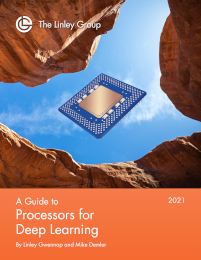
Take a Deep Dive into Deep Learning
Deep learning, also known as artificial intelligence (AI), has seen rapid changes and improvements over the past few years and is now being applied to a wide variety of applications. Typically implemented using neural networks, deep learning powers image recognition, voice processing, language translation, and many other web services in large data centers. It is an essential technology in self-driving cars, providing both object recognition and decision making. It is even used in smartphones, PCs, and embedded (IoT) systems.
Even the fastest CPUs are inadequate to efficiently execute the highly complex neural networks needed to address these advanced problems. Boosting performance requires more specialized hardware architectures. Graphics chips (GPUs) have become popular, particularly for the initial training function. Many other hardware approaches have recently emerged, including DSPs, FPGAs, and dedicated ASICs. Although these solutions promise order-of-magnitude improvements, GPU vendors are tuning their designs to better support deep learning.
Autonomous vehicles are an important application for deep learning. Vehicles don't implement training but instead focus on the simpler inference tasks. Even so, these vehicles require very powerful processors, but they are more constrained in cost and power than data-center servers, requiring different tradeoffs. Several chip vendors are delivering products specifically for this application; some automakers are developing their own ASICs instead.
Large chip vendors such as Intel and Nvidia currently generate the most revenue from deep-learning processors. But many startups, some well funded, have emerged to develop new, more customized architectures for deep learning; Cerebras, Graphcore, Greenwaves, Gyrfalcon, Groq, Horizon Robotics, Tenstorrent, and Untether are among the first to deliver products. Eschewing these options, leading data-center operators such as Alibaba, Amazon, and Google have developed their own hardware accelerators.
We Sort Out the Market and the Products
A Guide to Processors for Deep Learning covers hardware technologies and products from more than 55 companies. The 300+ page report provides deep technology analysis and head-to-head product comparisons, as well as analysis of company prospects in this rapidly developing market segment. We explain which products will win designs, and why. TechInsights’ unique technology analysis provides a forward-looking view, helping sort through competing claims and products.
The guide begins with a detailed overview of the market. We explain the basics of deep learning, the types of hardware acceleration, and the end markets, including a forecast for both automotive and data-center adoption. The heart of the report provides detailed technical coverage of announced chip products from AMD, Cambricon, Cerebras, Graphcore, Groq, Intel (including former Altera, Habana, Mobileye, and Movidius), Mythic, Nvidia (including Tegra and Tesla), NXP, and Xilinx. Other chapters cover Google’s TPU family of ASICs and Tesla’s autonomous-driving ASIC. We also include shorter profiles of numerous other companies developing AI chips of all sorts, including Amazon, Brainchip, Gyrfalcon, Hailo, Huawei, Lattice, Qualcomm, Synaptics, and Texas Instruments. Finally, we bring it all together with technical comparisons in each product category and our analysis and conclusions about this emerging market.
What's New in this Edition
- Engineers designing chips or systems for deep learning or autonomous vehicles
- Marketing and engineering staff at companies that sell related chips who need more information on processors for deep learning or autonomous vehicles
- Technology professionals who wish an introduction to deep learning, vision processing, or autonomous-driving systems
- Financial analysts who desire a hype-free analysis of deep-learning processors and of which chip suppliers are most likely to succeed
- Press and public-relations professionals who need to get up to speed on this emerging technology
This report is written for:
- Product managers and executives seeking to assess the performance of their product lines over the past year or to identify areas in which to invest or divest
- Strategic sourcing professionals and engineers at OEMs and operators seeking information about semiconductor suppliers
- Investors and financial analysts seeking data to support investment decisions












